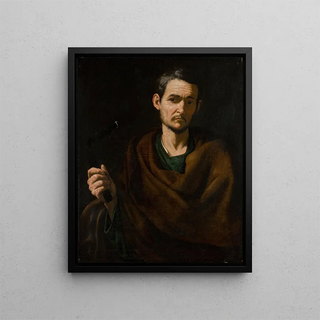Art print | Saint Matthieu - School of Jusepe de Ribera


View from behind

Frame (optional)
Reproduction of Saint Matthew - School of Jusepe de Ribera – Captivating Introduction
In the fascinating universe of baroque art, the "Saint Matthew" artwork from the School of Jusepe de Ribera stands out for its dramatic intensity and striking lighting. This painting, which highlights the figure of the apostle Matthew, evokes deep spirituality while revealing the artist's technical mastery. The scene, imbued with mystery, transports the viewer into a silent dialogue between the saint and the divine. Through an art print of Saint Matthew - School of Jusepe de Ribera, it is possible to rediscover this iconic work that embodies the aesthetic and religious values of its time.
Style and uniqueness of the work
Ribera's style is characterized by striking realism, where every detail is treated with remarkable precision. In "Saint Matthew," shadows and lights blend to create a striking contrast, typical of chiaroscuro that made baroque art famous. Matthew's posture, both humble and majestic, conveys a psychological depth that invites contemplation. The colors, rich and deep, give the scene an almost tangible atmosphere, where one feels the tension between the earthly and divine worlds. The way Ribera captures human emotions, while incorporating sacred elements, demonstrates a unique artistic approach that transcends the simple religious portrait.
The artist and his influence
Jusepe de Ribera, born in Spain and having spent much of his life in Italy, is an emblematic figure of the baroque. His work is marked by an intense exploration of the human condition, often through religious and mythological themes. Ribera managed to establish himself as a master of light and shadow, influencing many artists of his time and future generations. His style, which combines realism and spirituality, has left an indelible mark on art history. By depicting holy figures with such humanity, he redefined how sacred art was perceived, making the divine accessible and tangible for the viewer. Ribera's impact is still felt today, as his works

Matte finish

View from behind

Frame (optional)
Reproduction of Saint Matthew - School of Jusepe de Ribera – Captivating Introduction
In the fascinating universe of baroque art, the "Saint Matthew" artwork from the School of Jusepe de Ribera stands out for its dramatic intensity and striking lighting. This painting, which highlights the figure of the apostle Matthew, evokes deep spirituality while revealing the artist's technical mastery. The scene, imbued with mystery, transports the viewer into a silent dialogue between the saint and the divine. Through an art print of Saint Matthew - School of Jusepe de Ribera, it is possible to rediscover this iconic work that embodies the aesthetic and religious values of its time.
Style and uniqueness of the work
Ribera's style is characterized by striking realism, where every detail is treated with remarkable precision. In "Saint Matthew," shadows and lights blend to create a striking contrast, typical of chiaroscuro that made baroque art famous. Matthew's posture, both humble and majestic, conveys a psychological depth that invites contemplation. The colors, rich and deep, give the scene an almost tangible atmosphere, where one feels the tension between the earthly and divine worlds. The way Ribera captures human emotions, while incorporating sacred elements, demonstrates a unique artistic approach that transcends the simple religious portrait.
The artist and his influence
Jusepe de Ribera, born in Spain and having spent much of his life in Italy, is an emblematic figure of the baroque. His work is marked by an intense exploration of the human condition, often through religious and mythological themes. Ribera managed to establish himself as a master of light and shadow, influencing many artists of his time and future generations. His style, which combines realism and spirituality, has left an indelible mark on art history. By depicting holy figures with such humanity, he redefined how sacred art was perceived, making the divine accessible and tangible for the viewer. Ribera's impact is still felt today, as his works






